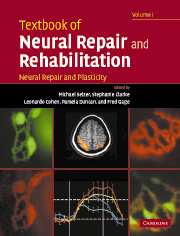Book contents
- Frontmatter
- Contents
- Contents (contents of Volume II)
- Preface
- Contributors (contributors of Volume I)
- Contributors (contributors of Volume II)
- Neural repair and rehabilitation: an introduction
- Section A Neural plasticity
- Section A1 Cellular and molecular mechanisms of neural plasticity
- Section A2 Functional plasticity in CNS system
- Section A3 Plasticity after injury to the CNS
- Section B1 Neural repair
- Section B2 Determinants of regeneration in the injured nervous system
- 21 Inhibitors of axonal regeneration
- 22 Effects of the glial scar and extracellular matrix molecules on axon regeneration
- 23 Trophic factors and their influence on regeneration
- 24 Intraneuronal determinants of regeneration
- Section B3 Promotion of regeneration in the injured nervous system
- Section B4 Translational research: application to human neural injury
- Index
23 - Trophic factors and their influence on regeneration
from Section B2 - Determinants of regeneration in the injured nervous system
Published online by Cambridge University Press: 05 March 2012
- Frontmatter
- Contents
- Contents (contents of Volume II)
- Preface
- Contributors (contributors of Volume I)
- Contributors (contributors of Volume II)
- Neural repair and rehabilitation: an introduction
- Section A Neural plasticity
- Section A1 Cellular and molecular mechanisms of neural plasticity
- Section A2 Functional plasticity in CNS system
- Section A3 Plasticity after injury to the CNS
- Section B1 Neural repair
- Section B2 Determinants of regeneration in the injured nervous system
- 21 Inhibitors of axonal regeneration
- 22 Effects of the glial scar and extracellular matrix molecules on axon regeneration
- 23 Trophic factors and their influence on regeneration
- 24 Intraneuronal determinants of regeneration
- Section B3 Promotion of regeneration in the injured nervous system
- Section B4 Translational research: application to human neural injury
- Index
Summary
Developing neurons in both the central and peripheral nervous system face many challenges. They must migrate to their proper location, extend an axon towards their correct post-synaptic targets and survive a period of naturally occurring cell death. The neurotrophic hypothesis, a basic tenet of developmental neurobiology, states that as developing neurons extend axons to their target tissues, their survival becomes dependent on soluble factors released from the target tissues in limiting amounts. After injuries that sever axons, the damaged neurons face many of the same problems as developing axons, that is they must survive, extend an axon, and if function is to be restored, make synapses with correct target cells. Consequently, it has often been suggested that supplying exogenous neurotrophins (NTs) might have therapeutic value after traumatic injury to the nervous system. In this chapter, we review the biology of NTs and their receptors with an emphasis on their use to encourage nerve regeneration after damage to both the central and peripheral nervous system.
NT family and receptors
NTs are secreted growth and differentiation factors that bind directly to receptor complexes on their target cells and exert multiple downstream effects. The NT family consists of four highly conserved proteins that are found in all mammalian species: nerve growth factor (NGF), brain-derived neurotrophic factor (BDNF), neurotrophin-3 (NT3), and neurotrophin-4 (NT4). NTs are synthesized as proproteins that are cleaved intracellularly by furin proteases to generate the mature 13.5-kDa protein (for review, see Teng and Hempstead, 2004).
Keywords
- Type
- Chapter
- Information
- Textbook of Neural Repair and Rehabilitation , pp. 405 - 420Publisher: Cambridge University PressPrint publication year: 2006
- 1
- Cited by

